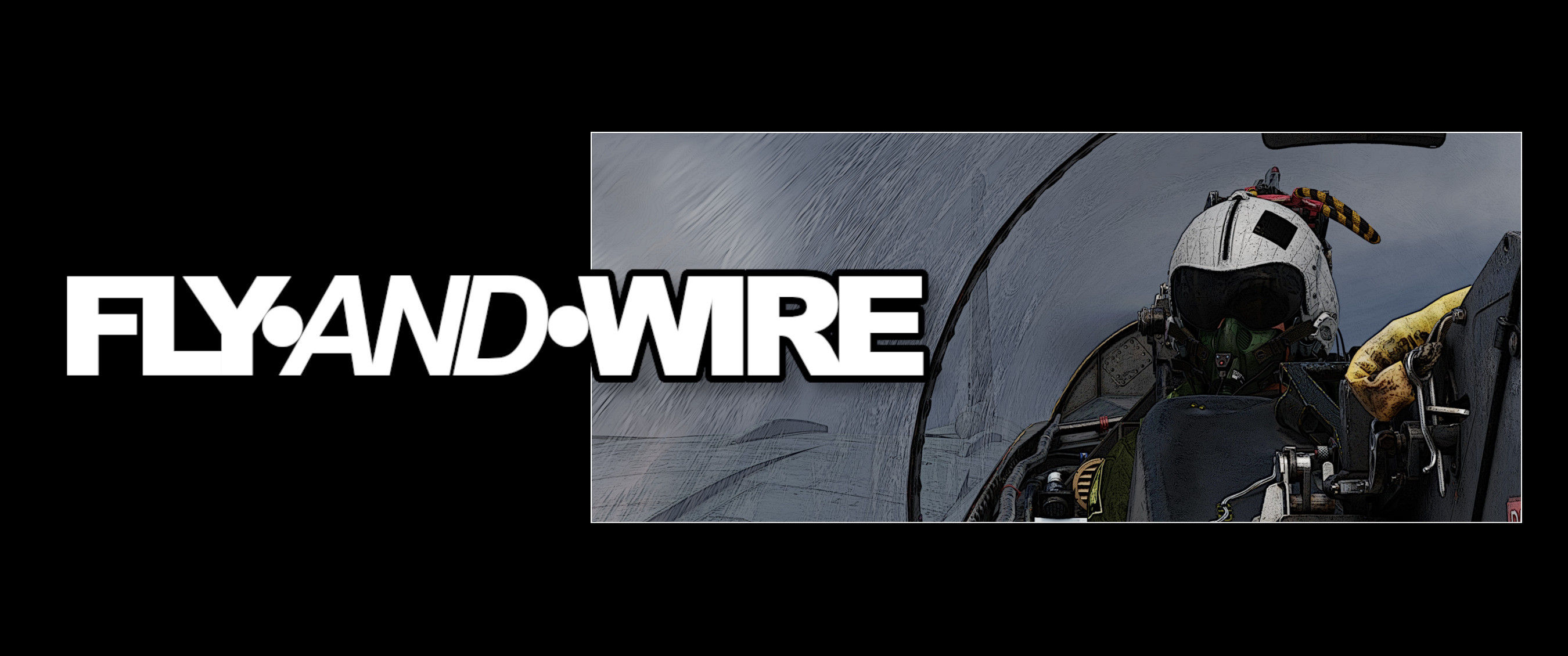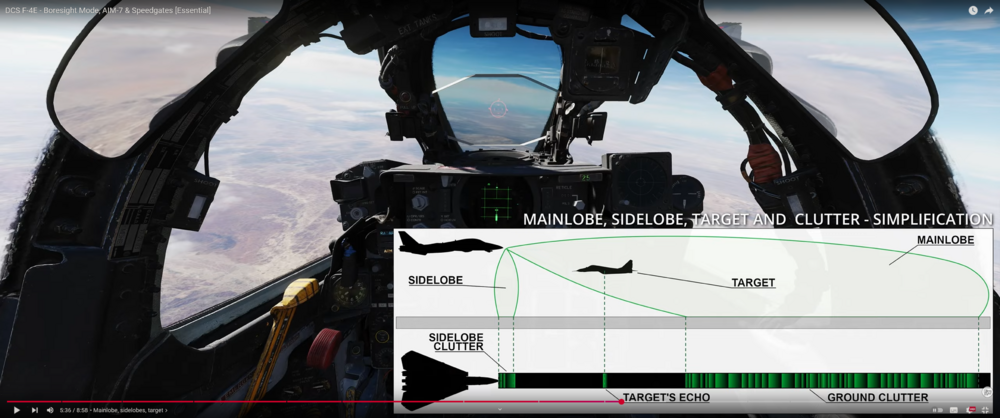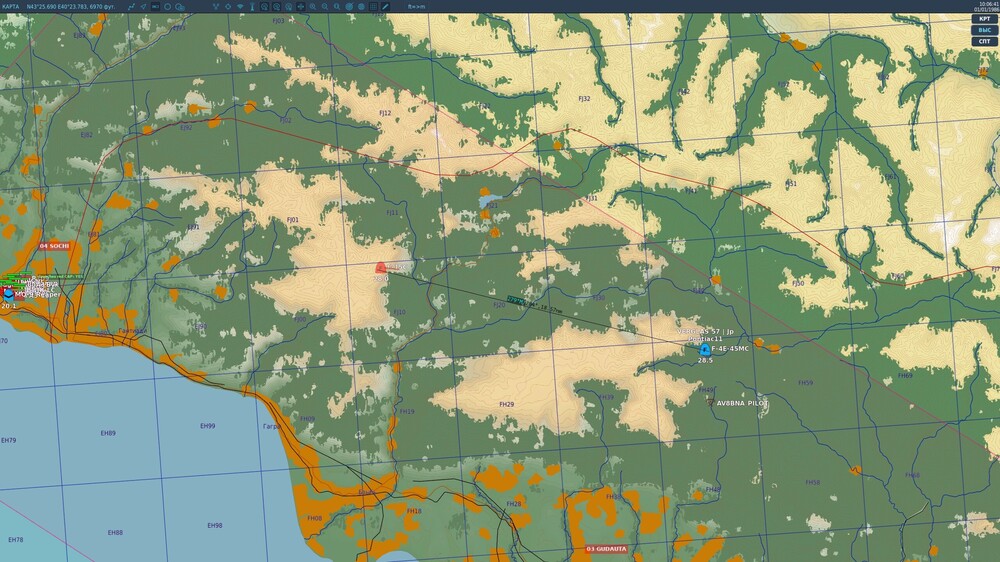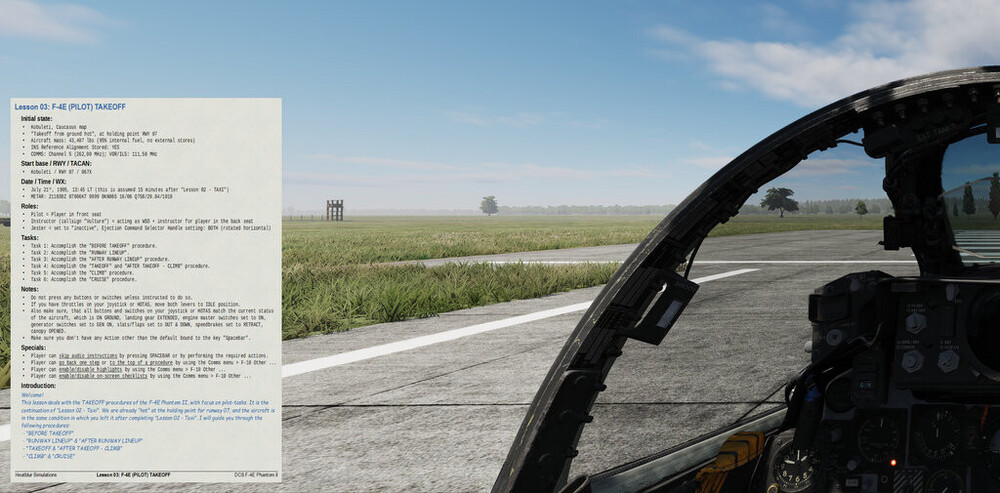-
Posts
1174 -
Joined
-
Last visited
-
Days Won
2
Content Type
Profiles
Forums
Events
Posts posted by Karon
-
-
Apologies, but I don't understand why you cannot do this stuff before the mission, and then load the results in the kneeboard.
-
 2
2
-
-
Regardless of this particular issue, if you want to compare empirical data, make sure you have repeated the data gathering at least 10-15 times. Then remove the outliers and check what happens. A single data collection is never sufficient: any tiny unload will accelerate you and, vice versa, and a slight climb will slow you down. Only then can you proceed (and will still be incorrect, but hopefully a bit less so).
-
 1
1
-
-
1 minute ago, NytHawk said:
Just to be extra pedantic, the EAP first flew in August 1986. The YF-22 even first flew in 1989.
LOL I really wanted to mention the F-22, but I skipped it because I was concerned people would miss the point. Although, reflecting on it, for the F-22 it's more that its raison d'être dates to the CW (reaction to new Soviet tech, MiG / Su, A-50, etc), but the tech and the design were futuristic for the era.
The Typhoon still fits in the CW thought process, but, unless we are playing an European Cold War version of The Final Countdown, I don't see it fitting an 80s scenario

Anyway, we are totally OT now...
-
 2
2
-
-
7 hours ago, TotenDead said:
Who cares why? Entered service in ~2003? It did. Good day to you sir then
Keyword here: "CW design". Not "CW-operational aeroplane" or "aeroplane that flew in the CW".
FFS, sometimes I wonder if people read or are just in a hurry to reply

-
 2
2
-
 1
1
-
-
1 hour ago, WarthogOsl said:
Yeah, I don't get why you'd need the zero doppler filter for that reason then.
Apologies, I am probably misunderstanding here. Are you wondering why there is a ZDF in Pulse mode?
I think the easiest way to look at it is the name itself: Zero | Doppler | Filter. Simplifying a lot, if there is no Doppler ( = Zero), then a Filter kicks in.
PD stands for Pulse Doppler, and it uses the Doppler principles to work, so you need a difference in relative speed. If two objects move at the same speed, there is no speed difference, so no Doppler. No Doppler → apply the filter.
I suppose there may be some returns, but they might be hard to process, or perhaps appear aleatory to the radar processing them (clutter from sidelobes?), and so they are removed - you need someone more expert on the matter for a good technical explanation. I never had the time to look into the technical side of radar processing, although I wish I could at some point.This is how ZDF looks in-game:
Back to the AWG-9, if you switch from PD to Pulse, the logic changes and, de facto, there are no filters. That's why you see everything (even too much if you used the bugged Gain knob). In fact, the raison d'être of Pulse is, among other things, to allow crews to operate in an environment where the target aspect can quickly change. MPRF would have been the better choice (but it comes with its own set of issues, range especially) but, from my understanding, MPRF processing with analogue hardware was not feasible in the Tomcat.
I hope this helps and not complicates things instead

-
 1
1
-
-
OK, look, we are going nowhere here. I just leave those here. 3 results out of the top 5:
https://www.theguardian.com/world/2024/nov/27/malta-summit-ends-the-cold-war-archive-1989http://news.bbc.co.uk/onthisday/hi/dates/stories/december/3/newsid_4119000/4119950.stm
https://coldwar.unc.edu/theme/end-of-the-cold-war/
Also, I would argue that the last batch of CW designs is possibly the Eurofighter, which arrived late precisely because the CW ended.
> What started in 1989 could have ended very differently if it wasn't Gorby leading the USSR
And, as we say where I'm from, "if my nonna had wheels, she'd be a wheelbarrow". Ergo, if you change something (history in this case), you get different results (AIM-120 and AIM-152 for the Tomcat, so go for it). You should have warned me that we were theorycrafting here; I wouldn't have entertained this conversation.-
 1
1
-
 1
1
-
-
1 hour ago, Dragon1-1 said:
The 9.12A is very much a Cold War aircraft, a contemporary of our F-14 variants. That it didn't change much into post-CW era is another matter, but in a mid-2000s Fox 3 fight, it's outclassed, even if the R-27ER can give it a surprising bite against sloppy NATO jet drivers.
The 9.12A was delivered to Poland, Czechoslovakia and East Germany in 1989/1990, at least according to sources on wikipedia. Other sources say that, for example, the first East German MiG-29s were delivered in mid-1988 and became fully operational in 1990.
The Cold War ended in 1989, with the last step in the dissolution of the USSR in 1991. We can argue that it started its final phase when someone took the relation between the two blocks out of the freezer a couple of years earlier, in 1987/88. Ergo, not really "very much a Cold War aircraft", but an aircraft that, in the version we are getting, arrived post-CW and, even in its original Soviet form, was relevant for what, 1-2% of the duration of the entire war?

Ref the ER, I find "game balance" as the justification for having weapons that "in theory" could be used quite laughable tbh. Everyone can do what they want with the game, of course, but just be conscious that looking for balance means throwing out the window any semblance of plausibility. War is a race; there is no balance, otherwise both Iraqi and Serbians would have complained with the admins right away in DS and Kosovo ( /s, in case someone has not realised it).
4 minutes ago, AeriaGloria said:It depends . We can verify that Yugoslavian MiG-29B delivered in 1989 could fire R-27ER if mounted because there manuals mention KMOD and the radar features that come with the BZPP-44 update.
I believe most MiG-29s were only exported after 1988, and including German MiGs that were later modified by MiG for wing tanks. So it’s conceivable to believe that any other MiG-29 that was delivered or upgraded from 1989 to later would be able to fire R-27ER
There is a specific MiG-29 manual that specifies all the different software updates. It gives me the impression that the Soviets and Russians did not update the software of their MiGs very often. There’s also the impact of procedure, if they save ER for other platforms, why right it in the manual even if it can technically carry it. I would think both possibilities could happen
Good info, thanks mate.
Do you have solid numbers about the ratio between R-27 and ER/ET versions? Because what I have (chats / interviews) indicates an almost complete usage of "plain" R-27. However, we know how anecdotal sources are...
-
 1
1
-
-
18 minutes ago, apolloace said:
Since you are on the ED Team, how long since we get the first glimpse of the Mig29 from Wags?
Not looking at a release date, but some kind of an update.
I'm a closed beta tester, but only for Heatblur - which does not mean that I don't raise issues for other products if I run into them.
I am not following the Fulcrum much at the moment, since it's de facto a post-CW aircraft, but I'm curious since the -29 is the first FF redfor released in years.
Updates will come as soon as there is more to share. For example, recently, there was news about the Corsair.
-
 4
4
-
-
As a sidenote, remember that an upgrade at a certain date does not immediately upgrade your weapon / aircraft stock to the newer version (anyone else misses Leonardo Da Vinci's workshop from Civ II? lol).
For instance, if you want to play a semi-realistic mission in Germany 1980s as a redfor, you will be facing fundamentally only F-4s, with only one TFW in all Europe sporting F-15s, even though the F-15 was technically introduced in 1976. Similarly, AIM-7F from the 70s were still around in the 90s.
Personally, if I ever feature one of these MiGs in a mission I design, it won't have an R-27ER/ET unless it's Russian/Soviet. Still, DCS is a sandbox, and airquake/casual servers or players who do not want to stick to reality may benefit from the ability to choose.
So... AIM-152 and AIM-120 to the Tomcat when?

-
 2
2
-
-
Which is incorrect, as it depends on where the mainlobe is. So, if you have a general idea of where the target is azm-wise (e.g. from the RWR), you can acquire a lock whilst looking down. You need a human, though, as it requires a bit of work on the radar. Once the lock is achieved, it is very hard to break.
null
-
 1
1
-
 1
1
-
-
After a few months sitting on these numbers, I finally gathered enough mental strength to deal with modern DCS

Jokes aside, here is the probable final part of the Thrust-to-weight ratio, performance and fuel consumption study. This time the focus is on the 16-17-18 triad: FFalcon, Jeff and Hornet.
-
18 hours ago, SpecteRED said:
I constantly encounter the problem that Jester doesn't see a target closer than 10 miles on the radar. And it doesn't matter how the target is directed (from me/to me). The screenshot shows that the target is 18 miles away and I can't see it - scan in the center. After that, I tried to descend to 1000-1500 feet, but it didn't help. In this case, the Jester detected the target at a distance of 9-10 miles. Then why is there a 50-mile range scale on the radar? its useless... I don't even understand why the scale is 25))
Is Jester that bad or the radar? or maybe both?))
This question resembles a lot the initial critiques of the F-14's Jester, which were caused mostly by a lack of understanding of the avionics and Tomcat systems.
So, since you said Jester did not see the target, could you spot it on the radar instead?
Btw, the 50nm scale is sometimes barely enough. A lot depends on the conditions you are facing.
-
-
Great work, thanks!
-
On 3/16/2025 at 10:21 AM, TheBiggerBass said:
I just asked the devs and linked your post. They'll check here or let me know if there's a better solution than unpacking the miz. Thanks!
In the meantime, may I suggest a magnifying glass?
> I already asked that question in the Heat Blur section but did not see any response yet. This section seems to be much faster.That's the Italian section of ED's forum though

-
Quick old tip of mine:
CPTR PILOT → CCIP
CPTR TARGET → CCRP
CCIP is a very unsafe delivery method. As Tau mentioned, tossing prevents you from flying too close to the target (and it is also a lot of fun - self lasing especially).
CPTR IP is something different, and it can help you find the correct target if the area is cluttered. -
Last part of the INS discussion: Visual/Radar fix updates. Bonus: the NS430 is back, with an unexpected supporter

-
 2
2
-
 3
3
-
-
Hey folks, continuing the INS Navigation discussion in the F-4E, I started to look into the fix updates methods. I hope this can be useful to you.
-
 3
3
-
 3
3
-
-
Something different for once, a broad discussion about SARH employment: ranges, timeline, tactics and more.
-
 1
1
-
 2
2
-
-
Back to Back to Basics!
This chapter of the Back to Basics series focuses on the INS, the acronym for Inertial Navigation System. Often misunderstood or taken for granted, understanding the limitations, features, and potential issues of the INS is fundamental, along with knowing the alternative means the crew can use for navigation.
Article: https://flyandwire.com/2025/02/13/back-to-basics-ins-drift-and-navigation/-
 2
2
-
-
21 hours ago, Omega417 said:
Right, I also have next to 0 time in the back seat. But your explanation makes way way more sense to me now.
Glad it helped

I think both F-14 and F-4 pilots need to spend some time in the backseat, whether they fly solo with Jester or a human. Having a decent understanding of "all-thing-in-the-back" definitely helps to better understand properties, capabilities and limitations of the aeroplane.
-
8 hours ago, Omega417 said:
3:09 was exactly what I have been miss understanding. I was always so confused about how I could be on "TGT 2" and editing the LAT/LONG without it actively changing the display on the BDHI.
As I mentioned in the first video, at ~2:10, I think it is easier to see "reset" as "re + set" or "set again". If you think about it, the prefix "re-" stands for "redo" or "repeat", in a sense.
About TGT1/2, I think you can see #1 as the first, immediate value. Ergo, straight from the target counters. #2 is secondary, or indirect. Therefore, the memory. Or, you can follow @Zabuzard's tip and simply memorise the functions. Whatever works for you

-
Hey folks!
This is a sort of follow-up to Leapfrogging and discusses the usage of Bullseye with the AN/ASN-63 INS and -46A Nav Computer. If Leap Frog ops used TGT2 and Memory, Bullseye and similar nav references use TGT1.
Let me know if this is interesting for you, I don't want to spam not-useful content

-
 2
2
-
 3
3
-
-
Hey folks,
I made a quick video about a topic that I considered well explained in the manual, but given the feedback, it is apparently less intuitive than I thought initially. So, here is a neat navigation technique: "leapfrogging".
Since the AN/ASN-46A can store only one point, the WSO (Wonderfully Sexy Operator) can apply this method to ensure no delays when switching waypoints. Also, it enables bullseye / other references whilst maintaining the ability to immediately revert to the current steer point and vice versa.
The idea is well described in the manual: TGT2 is used for navigation, thus leaving the Target Counters free to be manipulated. As the SP gets close, the WSO can input the new point latlongs, then turn the Nav Comp Mode knob to RESET. This causes the memory to be overwritten. Now, the GIB (Gorgeous In the Back) can switch back to TGT2, and the BDHI will show the new nav info. If you are confused, check the video or the article below.
-
Article: https://flyandwire.com/2025/01/30/f-4e-leap-frog-operations/
-
HB F-4E Manual: https://f4.manuals.heatblur.se/jester/navigation.html?highlight=leapfrogging#operation
-
More F-4E Articles: https://flyandwire.com/f-4e-phantom-ii-articles/
I hope this is useful to you. The next videos will be about bullseyes in the F-4E (something I already mentioned here) and INS alignment (yeah, no AHRS shenanigans for land-based aircraft!!). Feel free to suggest more simple-but-not-really topics.
Post scriptum: shoutout to HB and their SMEs. I have been accumulating content about the F-4 since long before its release, but every time I jump into it, I notice new, subtle but great details.
-
 7
7
-
 8
8
-






F4E - Navigation Kneeboard - Waypoint Leg/Distance and selectable speed - thoughts?
in DCS: F-4E Phantom
Posted
Calm down, son. Catch a deep breath rather than going full reheat against someone who started with "Apologies". Also, it is a legit question since this has been done for what, 17 years? You know, copy coordinates either directly from the game or to a piece of paper, plan before the mission itself on the F10 map, Google Maps, CFlite, and make your own spreadsheet. But you want something in-game, right? Is the ruler not enough? Drag a line and call it day. Why does that not work? You can also write the results on the canopy itself, instead of using openkneeboard. Actually, I will record a brief video to show you how you can open a map, drag a line, write two numbers. Already in-game, already in VR, takes a minute. This would be so much more coherent with your statement. Ad verbatim:
> It would be most beneficial for just about every single phantom player that really wants to play with the module in the spirit of true gen 3 aviation.
But I doubt you want that. In fact:
> This is about getting basic information calculations into the kneeboard from the off, which is easy for a PC to do if you have known GPS positions. Having the bearing and distance to the next waypoint as part of the kneeboard would be invaluable.
These are not really basic, but OK. If I understand correctly (my English is not great - "from the off"? Off mission, off track, off what?), you want something that knows your position as well. I thought we wanted a "true gen 3 aviation" experience here. Anyhow, since you want a GPS, the NS430 works perfectly (it also lets you cheat when updating the INS Fix, but don't tell any real pilot, they get mad because they never thought about it /s ). I have an F-4E/G EWO/WSO and a F-4F pilot who mentions that they used actual GPS in the Phantom in their career. If you want no GPS, then the solution is simple: INS, pilotage and DR.
But I see it's not over:
> It was then a logical progression to have a speed table to calculate times on the fly in a vertical column, or even two columns would make sense.
Ok, now you want multiple speeds. So, to recap the necessary parameters to do what you want, we need:
I can think of more parameters, but this should give a general idea. The first 4, besides the course, require manual input. Wind is interesting because it is a big factor that should be accounted for IRL. But wind changes. So, do you want it fetched in real time in DCS? What happens when the dynamic weather arrives? Anyway, the input part is getting crowded already. But then you want fuel as well. OK, easy to do. Should DI and weight be calculated in real time and fetched in DCS? Or at the beginning of the mission? Or at the first WP? Is the first IP the ingress/reference or just a turn? What if there is an AAR scheduled before or after? What if you are delayed? How do you plan for a dogleg/trombone fuel-wise? All these variables should be specified somewhere. This kneeboard is getting a tad tiny for the purpose.
However, up to here, it's all easy. But then the problems start: DCS players.
Imagine you build your mission and flight plan from the mission editor and share it. Altitude is 10,000ft, speed 360, 2000 ft 420 kts at the ingress, 540 kts at IP and delivery. Player A flies instead at 6,000 ft the whole mission and at 450 kts. The plan says he can make it fuel-wise, but he uses reheat for too long at departure, or perhaps loads a couple bombs more, and he runs out of fuel. The next thing he does is go and complain because the kneeboard doesn't work. I know because, throughout the years, I answered so many complaining about the AIM-54's crappy performance, when the fault was all theirs.
The alternative would be to recalculate everything in real time: positions, timing, fuel, speeds, DI, wind, magvar, et cetera. Feasible for sure, but then you are asking for functions present in the modern Hornet and a GPS. Not really "gen 3 aviation" vibes here. Why not use the NS430 at this point? It is actually realistic past a certain time frame.
The point I'm trying to make is quite simple: either devs make something very basic, like course and distance from the specified points and leave out player-influenced parameters, or you make a thorough tool. The former can be done already with no additional tools, both in VR and pancake, and takes a minute. Seriously, I'll put a video together when I have time.
The latter requires more work, but this must not be on HB's shoulders. It should be a concerted effort driven by ED. There should be a proper planning tool before pressing "Fly", opening a mission editor-like page, where all the parameters can be set. A nice, full-screen tool, with all the appropriate parameters, where the members of the package can be specified and the plan shared (not only across groups, as on casual servers, this does not work), and so on. Something that works across modules, with the option of having Jester ready to input coordinates right after startup, and creates a series of reference kneeboard pages.
Ideally, something that spits out something like this: https://flyandwire.com/wp-content/uploads/2025/04/low-level-planning-tool-launch-example-map.jpeg
It is quite simple to do, in my opinion (but of course, I don't know what's under the DCS hood, so it may be very complicated instead). It's all a matter of resources, priorities, and time. ED already has a lot to do in this regard. Nevertheless, a planning tool, a TacView and LotATC equivalents should be part of DCS already. The in-game VoIP is a good first step, but it'd be great to see more basic functionalities "returning to DCS". Again, this is not a 3rd party's job to do, no matter how cool and sexy they are
So, if you want something like that, I'm all aboard for it, just tell me where to sign. A kneeboard page instead is good to present an output, but there are too many parameters to be considered if you want to do a thorough job, and, imo, it is not worth the dev's time.
What do you think?